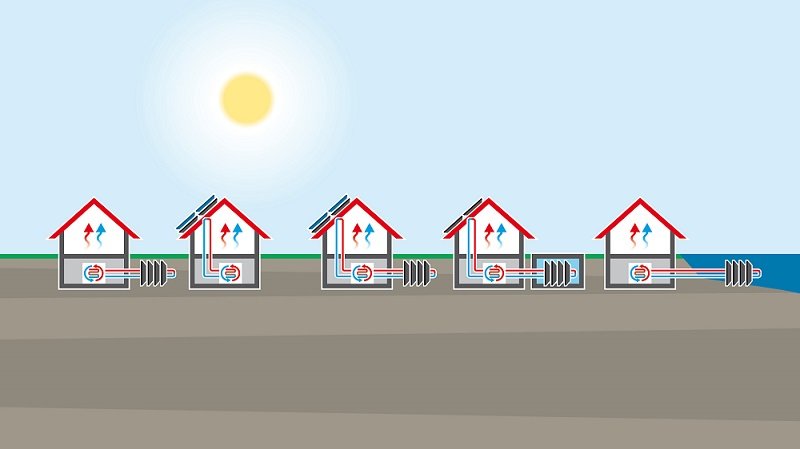
OptiSource Heat Pump Systems
The OptiSource System
-
OptiSource systems use all-electric water-source heat pumps combined with our exclusive M-Therm Heat Exchangers to provide heating, cooling, and water heating.
-
OptiSource heat pump systems are geoexchange systems which reduces the effect extreme cold and hot climates have on the system. Their easy hybridization provides additional security and resilience in even the harshest of climates.
-
OptiSource systems provide heating, cooling, and water heating using water-source heat pumps. Water-to-air heat pumps provide ducted options while water-to-water heat pumps allow for ductless and radiant solutions to be used.
-
OptiSource heat pump systems can be installed in single family homes or they can be scaled up as part of a larger community thermal energy network.
CapiTherm GeoExchange Mats
-
An M-Therm Mat is a polymer heat exchanger made up of numerous thin-wall capillary tubes to form a flat mat that can be buried under ground, under structures, or submerged under water to provide heating, cooling and domestic hot water for residential, commercial and industrial projects.
-
MultiTherme Mats are constructed out of the same high density polyethylene (HDPE) materials used in ground-source heat pump systems for years. The capillary tubes are SDR8 and the headers are SDR10.
-
Like the HDPE used in natural gas lines and ground-source heat pump systems for many years, HyperLoops have a life expectancy over 100-years. Yep, they’ll probably outlast the building they service!
-
Each MultiTherme Mat is 12.5’ long x 4’ wide and has a surface area of approximately 131 square feet, roughly equivalent to what would be achieved with 1” SDR11 HDP
-
MultiTherme Mats have a working pressure equal to 58 PSI @ 104°F and 30 PSI @ 140°F
-
MultiTherme Mats are brand agnostic. Any water-source heat pump that has been configured for used with ground-source heat exchangers can be used with HyperLoops.
-
Upon receipt at the jobsite, each M-Therm heat exchanger undergoes a 75 PSI air pressure test. Upon completion of the horizontal header piping, an additional 75 PSI air test is conducted. Prior to backfilling, a 75 PSI water test is conducted on the full system. The pressure drop across the system is observed through the completion of the backfilling and concrete floor pour if installed under a building’s footprint.
Where Can M-Therm GeoExchange Mats Be Installed?
-

Under Structure
M-Therm heat exchangers were designed to be installed almost anywhere, including underneath the building itself without comprising structural integrity or worry about leaks.
-

Horizontal
When space permits, M-Therm heat exchangers can be installed horizontally under parking lots, driveways, yards - virtually any open space.
-
Vertical
Great for retrofit applications and where space is limited, the M-Therm heat exchangers can be installed vertically to maximize the usage of space surrounding existing homes and buildings.
-

Water
If there’s a pond or lake nearby, this is the easiest and most energy efficient method of using the M-Therm heat exchangers
-

Porosity Storage
Similar to a water installation, we partner with the team at Porosity Storage to install the M-Therm heat exchangersinto their underground water storage reservoirs.
Hybrid System Options
What if I live in a cold climate with limited space on-site?
What if I live in a hot climate with limited space on-site?
What if there’s not enough room on my site for the heat exchangers at all?
OptiSource systems can adapt to almost any on-site restriction by incorporating various alternate methods of adding and removing heat to the water loop.
SOLAR THERMAL
Solar Thermal Collectors Add Heat To The Loop
WATER
Surface or subsurface water adds heat to and moves heat from the loop.
PHASE CHANGE
Ice or phase change materials add heat to and/or remove heat from the loop.
FLUID COOLER
A hybrid dry/evaporative fluid cooler removes heat from the water loop
ELECTRIC BOILER
A small electric boiler adds heat to the water loop
GAS BOILER
A small natural gas boiler adds heat to the water loop









